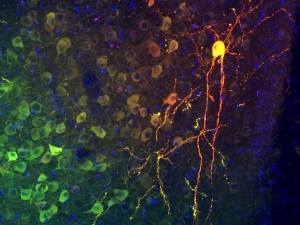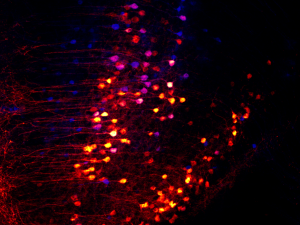In the lab we’re interested in how we build cognitive models of our environment on the basis of our past experience. These models are built from many different types of learnt associations stored in different neuronal populations throughout the brain. Which types of associations are encoded- or brought to mind at any particular time – is dependent on a complex interplay of factors driven by interactions at the circuit level.
At the center of these circuits is the ventral tegmental area (VTA). Dopamine neurons in this region send out a teaching signal to drive the development of learnt associations throughout the brain. This signal is exhibited when dopamine neurons detect a difference in what we thought was going to happen relative to what occurred in reality, to drive learning when something unexpected occurs and we need to update our internal model of the world. Dopamine neurons receive dense projections from many regions of the brain, containing information about an upcoming prediction given a particular scenario. Imagine you’re deciding where to go for dinner on a Friday night. You might consider visiting your local sushi restaurant. Or perhaps you had sushi last Friday night, and you’re instead leaning towards a good old-fashioned pizza. In order to allow you to make the right decision, different aspects of your expectations about going to either restaurant will be conjured up by different brain regions. For example, your hippocampus might tell you the different routes to get there, and the lateral hypothalamus might help you remember the particular foods you’ve enjoyed at either restaurant in the past (your favorite ebi tempura with teriyaki sauce!). Once you’ve made your choice, if you encounter something unexpected, dopamine neurons will send out a teaching signal, calculated by comparing your expectations made available by the rest of the brain with your current experience. So, if you settle on the pizza place and you end up having an underwhelming margarita, this teaching signal will update of your model and might sway you to choose sushi next week.
The lab is interested in exploring how different parts of the brain interact to build these cognitive models, so that we can learn from our experiences like our Friday night dinner choice. Disruptions in this process can contribute to a broad range of psychological disorders including schizophrenia, addiction, anxiety, and post-traumatic stress disorder (PTSD). We are particularly interested in schizophrenia and addiction. Both these disorders are thought to arise in part from deficits in the development and deployment of cognitive models. We study the nature of these cognitive deficits and how a disruption of particular neural circuits may produce them. Our hope is that if we can understand how learning is disrupted in these disorders, it will provide the impetus to develop novel therapeutic compounds targeting the neural circuits we know are important for these aspects of learning, to reduce symptoms and improve quality of life in patients.
Images on this page courtesy of Anna Beyeler (left) and Cody Siciliano (right)


